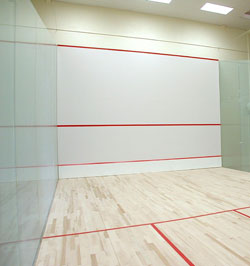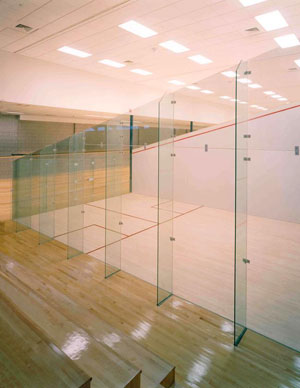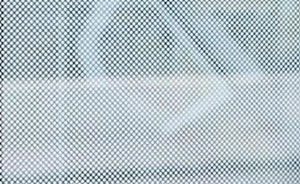Vision
Enhancement
Vision Enhancement Technology
A Best Enterprises, the leader in structural glass wall systems for Squash, Racquetball and Handball courts, offers a variety of vision enhancement systems to improve playability and spectator viewing.
Glass courts have traditionally been used to benefit the spectators of the sport. Glass adds an aesthetic appeal to a facility, improves social interaction between spectators and players and aids in tournament refereeing and coaching. All of these benefits have marginally compromised the playability of the court, particularly if one or more side wall is constructed from glass. The player needs a high contrast surface to judge the rebound of the ball off of the glass.
For glass backs wall A Best Enterprises offers as standard white play lines. This system is a permanently applied ceramic frit of white play lines, 1/8" wide, 1" on-center, applied to the bottom 30" of the wall. Since most rebounds are occur on the bottom portion of the glass, this is all that is required.

Doubleview I
DOUBLEVIEW I is a white opaque pattern applied to the interior surface of the glass. The combination of pattern, color and texture greatly aids the player’s view of the ball as it rebounds off of the wall. The pattern is a reverse dot image with holes aligned in a proprietary cluster pattern. This minimizes the effect of the human brain to "line-up" the dots or holes in vertical or horizontal patterns. Spectators and players viewing dots or holes aligned in vertical columns or horizontal rows will see the illusion of shimmering or waviness on the glass similar to a mirage in the desert. This causes dizziness as the players’ eyes pan pass across the glass. DOUBLEVIEW I greatly minimizes this effect.
Unlike dots, the tight registration of the negative pattern of DOUBLEVIEW I paints only the spaces between the holes. This allows for a minimum coverage of the surface area which maximizes spectator viewing while simultaneously providing excellent contrast for the players. The paint, or frit, is applied to the glass and then baked onto the surface during the tempering process thereby transforming the pigment into a permanent addition to the glass.
Doubleview II
The best method to create a clear view into the court while simultaneously providing high contrast for players on the interior surface, is to trick the eye into believing that something exists where it doesn’t and to deceive it into believing that nothing exists when it does. DOUBLEVIEW II accomplishes this through a 2-color, white-on-black negative dot application.
Like DOUBLEVIEW I, the effect is created using a ceramic application that is permanently baked onto the court-side surface of the glass during the tempering process. The pattern in both systems is also identical – a negative dot pattern which paints only the spaces between the dots. The holes are aligned in a proprietary cluster pattern which minimizes the shimmering or waviness inherent to other systems that align dots into vertical columns or horizontal rows. The tight registration of the DOUBLEVIEW II pattern minimizes coverage of the surface area which maximizes spectator viewing while simultaneously providing excellent contrast for the players.
DOUBLEVIEW II, however, first paints a black frit onto the glass followed by white frit which is perfectly superimposed on top of the first black layer. All of the frit is on the court-side surface, but black faces the spectators and white faces the players. The white pattern reflects the ambient light on the interior of the court fooling the eye into thinking that the wall is solid, while the black pattern facing the exterior of the court absorbs the light fooling the eye into believing that the glass is clear. This effect is even more dramatic if the light saturation on the exterior of the court is slightly less than on the inside of the court. This is exactly the same technique that is used on the sides of buses, where large graphics are painted on the sides of the vehicle and continue across the windows.


Powder Coated White
High Contrast for Greater Visibility
Other manufactures typically use large black polyurethane hinges and attaching hardware. DOUBLEPLAY structural glass walls use white powder coated hardware. There is no tendency for the player to lose sight of the ball against a dark background. The white hardware creates a dramatic contrast with the ball. Other manufactures have attempted to make their polyurethane components white, but they turn yellow after only a few years due to the ultraviolet light inside a sports facility. The powder-coated surface of the DOUBLEPLAY hardware is impervious to ultraviolet radiation.

Request More Information